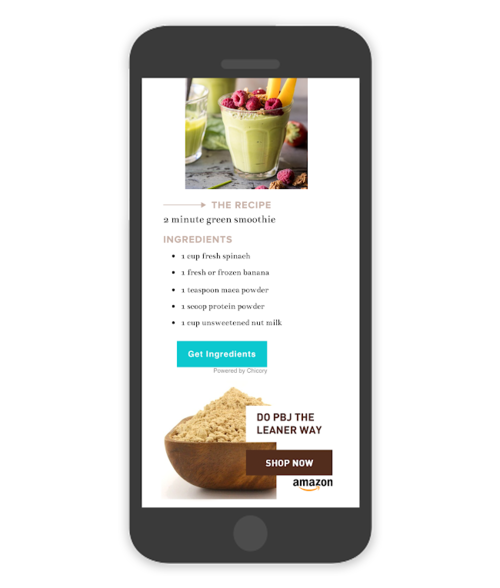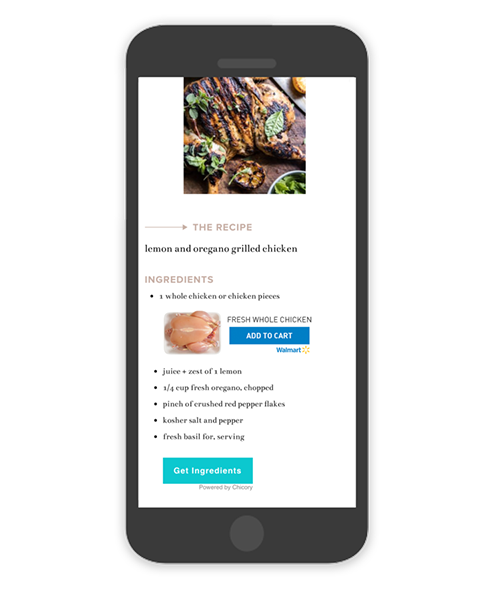The Online Impulse Buy: Reaching Health-Minded Consumers with Recipe Media
We’ve always been firm believers that recipes are where people start their food shopping journeys.
And we still are.
But recently we’ve realized that browsing recipes goes beyond looking for something to make for dinner tomorrow night—it’s a manifestation of one’s personal aspirations.
Think back to the last time you planned your grocery list. What did you think about? Did you immediately write down a bunch of random ingredients, or did you take a moment to plan according to a goal? Did you think, “I want to eat clean this week,” “I want to meal prep my lunches for the week,” or “I want to make something the kids will love?”
It’s easy to overlook, but when you plan your meals, you plan for life too. You’re planning what you’ll eat Tuesday night after a hectic day and what the kids will want when they come home starving after soccer practice.
The act of thinking about the week ahead is when personal aspirations shine through the most.
And at these moments, people are open to new things. They’re searching for those quick and easy weeknight meals or hearty casseroles on recipe sites and Pinterest boards.
They also have the time to reflect on the choices they’re making.
So, when Liz, a mom of three, finds a recipe for Broccoli Chicken Casserole, she has that extra second to think about how she can make it healthier for her family. Maybe it’s as simple as choosing organic chicken or swapping out regular mayonnaise for a lighter, lower-fat version.
One of the major things we’ve learned about online recipe users and grocery shoppers is that they plan ahead. And that changes how impulse purchases are made. Online, impulse changes from grabbing that candy bar at checkout, and transforms into a moment when a person activates on the life they want to live.
And when shoppers are online, looking for healthy meal ideas, or planning their kids’ lunches for the week, they are more likely to activate on impulses that promise an aspirational lifestyle.
How do we know? We’ve worked with a number of health food brands promoting items like powdered peanut butter, organic chia seeds, avocado oil mayonnaise, sugar replacements and natural chicken, which offer consumers just this—the opportunity to find healthy swaps during their planning. Engagement rates soar on these campaigns, compared to other more standard, pantry-packing items.
This 2019, take advantage of Instagrammy aspirations and provide the promise of a better life to your consumers. Here are our best practices for doing this, based on a handful of recent, successful campaigns:
Capitalize on Key Moments
Some brands opted to advertise in-line and make cooking a healthier event. People saw those ads right when they were most concerned about planning their meals—the mindset you want to capture.
Promote Wellness
When online users are browsing the web, they’re planning and thinking ahead. Rather than act on emotion (ahem, grabbing that candy bar in a hangry moment at the convenience store), they’re using their heads. So, appeal to the part of them that wants to be better, or the rational side of the consumer who knows they should go organic or be eating more nutrient-rich food. Do this primarily in your imagery and copy, using words like “more protein!” or “the healthy choice!”
Dieting is Different
The online consumer is educated and savvy. They are less likely to be looking for a quick fix, and more likely to be seeking good-for-you solutions. So, we’ve seen more success with products that promote nutrition, natural living and overall wellness, rather than promoting lower calories or less fat.
Make it About Lifestyle
Often, we have companies coming to us seeking to promote a single item as an alternative to another item (think ads for organic chicken any time “chicken” is mentioned in a recipe). But, what we’ve seen as a more successful strategy is to use lifestyle alignments. For the powdered peanut butter brand, mentioned above, we targeted all smoothies and protein shakes, inserting an ad into those recipes for the high-protein ingredient. The logic here is that folks looking for healthy breakfast ideas or post-workout snacks are the most likely consumers—not necessarily all peanut butter buyers. And the results showed 40% higher engagement than 1:1 ingredient targeting.
Give Them an Action
When buyers are feeling aspirational, they’re more likely to convert. Hello, this is why a zillion gym memberships get activated in January, even if they go unused for months thereafter. Give consumers an opportunity to engage with your brand right away like to make these ads shoppable, but promoting recipes works too. This is a moment to encourage consumers to continue to engage, not raise broad awareness or bring them to a funky landing page. Make the action they take matter.
If the food trend predictions are right, 2019 will be all about healthy alternatives to traditional products and alternatives that have sustainability in mind. Latch onto these trends by driving engagement with your brand and its messages using recipes. Who knows—maybe 2020 will be the year your plant-based gummy bears will take off (a girl can dream, right??).


